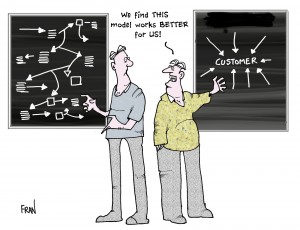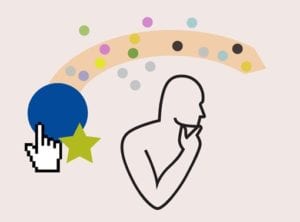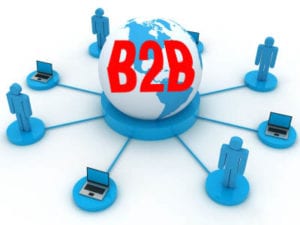To Find Your Customers, Reverse Your Own Customer Journey

Marketers are Customers Too!
We’re all so busy trying to figure out how to reach customers, we forget (except when we read otherwise?) that we too are customers! We buy a lot more than we sell!
So in mapping the customer journey and trying to figure out how they might reach us, rather than trying to get inside the heads of buyer personas or other constructs, why not simply map our own paths from the first inkling that we need something, until we actually buy it? What will initially spark our interest and ultimately make us enter that credit card number into a secure website? More importantly, what will keep us coming back?
Perhaps more relevant is exactly what gets YOU to decide between the myriad, highly seductive, ‘can’t do without’ offerings that are can’t miss bargains for $49.99 a month, that will help YOUR business get to a new level.
My B2B buying journey, and I dare say yours, is very much a logical extension of my consumer purchasing habits.
So, if 60% of the typical buyer’s journey is complete before they contact Sales – I must be atypical here, because I’m sure that for me, the percentage is far higher – what constitutes that 60%?
This Infographic, from pardot.com, is an excellent graphical representation of the typical path, and I certainly recognise some aspects of me in it. But we’re not all alike. Have you truly considered your own path, let alone mapped it?
My Consumer Buying Journey
 My consumer buying patterns are very much on a theme, and will be quite similar whether I am shopping on Amazon, looking for a restaurant or deciding on a movie.
My consumer buying patterns are very much on a theme, and will be quite similar whether I am shopping on Amazon, looking for a restaurant or deciding on a movie.
- Enter my search
- Read the blurb
- Read the reviews
- Read Industry Magazine or Consumer Reports reviews, if applicable
- Pay particular attention to those who speak in a voice akin to my own
- Pay even more attention to any comments regarding customer service
The last two points are key and the reason why sometimes, I stay away from more popular offerings or choose in favour of those with not the very best reviews overall.
If the reviewer is talking about key points that resonate more with me than those of the more status quo reviewer, or if (s)he simply writes in a manner that I could see myself writing, I go with that person.
Customer Service reviews are really important! Things go wrong. We all know this and sometimes the issue might originate with us. So I don’t see the fact that there was a need for Customer Service as being a negative. It is an inevitable part of doing business. But how has the person or company reacted when there has been a problem with their product or service?
I actually make a point of leaving this type of feedback, when I have encountered issues. It is so important to my decision making process, I try speaking to those who place the same value on it as I do.
Adapting the process to B2B
A fair proportion of B2B buying is easier than consumer buying, as you will seek and be offered advice from trusted associates, and find that it is recommended by others, such as your web designer. But what about those times when such advice is neither sought nor forthcoming, perhaps because you don’t yet know exactly what you want?
Research, research, research!
Let’s set the table first. I started in what is by now very much dinosaur tech, and have moved with the times to the extent that someone still working a day job, yet determined to become ever-more immersed in Social Media, can.
There is a repeating technology cycle:
- Build something complicated that relatively few can master
- Build other tools to make the above more simple
- Build new tools that are even more complicated than the previous round
Whereas ‘complicated’ may not be as impenetrable now as it once was, it is the sheer volume of offerings, and how many different products (software, apps, plug-ins) you need for a business, that overwhelms. Some have the bells, others the whistles, and 50 more have some of each. How do we cut through the tangle to find what is right for us?
Semantic Search
Semantic Search is friend to seller and purchaser alike. Whether I’m researching products from the standpoint of a purchaser or possible innovator, I enter conversational searches. Ask Jeeves, later simply Ask.com, was the first to encourage this type of search, but the back-end simply picked out the important words and ignored the rest.
By now, whereas predictive search will make suggestions as a search argument is entered, your question may match a long-tail keyword and directly hit exactly what you were searching for. This is the key to both finding and being found.
My B2B Buying Journey
 There are certain presumptions here. Most notably, I will have exhausted all of my trusted knowledge sources before embarking on this journey.
There are certain presumptions here. Most notably, I will have exhausted all of my trusted knowledge sources before embarking on this journey.
- Identify a need, which I presumably cannot yet fully define or adequately describe
- Enter and refine my long-tail search, remaining open to semantic suggestions
- Use my search findings to better understand how the marketplace can meet my needs
- Make sure to note the gaps as potential areas of collaboration!
- Identify the offerings that look worthy of closer examination
- That 156 character meta description in your WordPress, is just so important here
- Read the blurb
- Read the ‘About’ pages. What is the story behind the offering?
- Read Industry Magazine or peer reviews, if available (This may be the first step, if my need is more mainstream)
- Read the customer reviews
- Pay particular attention to those who speak in a voice akin to my own
- I am willing to go to the second or third (and rarely, even lower) results page in order to find this type of match
- Pay even more attention to any comments regarding customer service
- If Technical Support is slow or difficult to reach, this is good reason to avoid a company
- How easy is the sign-up process?
- If a company doesn’t have this aspect handled, what else have they overlooked?
- Discuss findings
- Make decision
So that’s me the customer. I doubt I am particularly unique, so why wouldn’t I try to create my ideal Customer Journey if I am the vendor?
What do you do differently to the above when you are on the consumer side?
Do you try to create a journey for your potential customers, akin to your own path when you are the customer?
Image attribution: Featured Image: https://www.espatial.com/articles/customer-mapping-vs-customer-journey-mapping
http://www.mckinsey.com/insights/marketing_sales/the_consumer_decision_journey
http://jeffpulvino.com/five-awesome-b2b-social-media-statistics/
http://transparencyjobs.com/category/uncategorized/
Andy Capaloff
Latest posts by Andy Capaloff (see all)
- The Art of Asking Questions [Interactive] - October 17, 2023
- The Metaverse Is Not Dead. It’s Resting! - September 6, 2023
- How Can You Hire For Jobs That Nobody Has Experience In? Aptitude! - June 13, 2023


